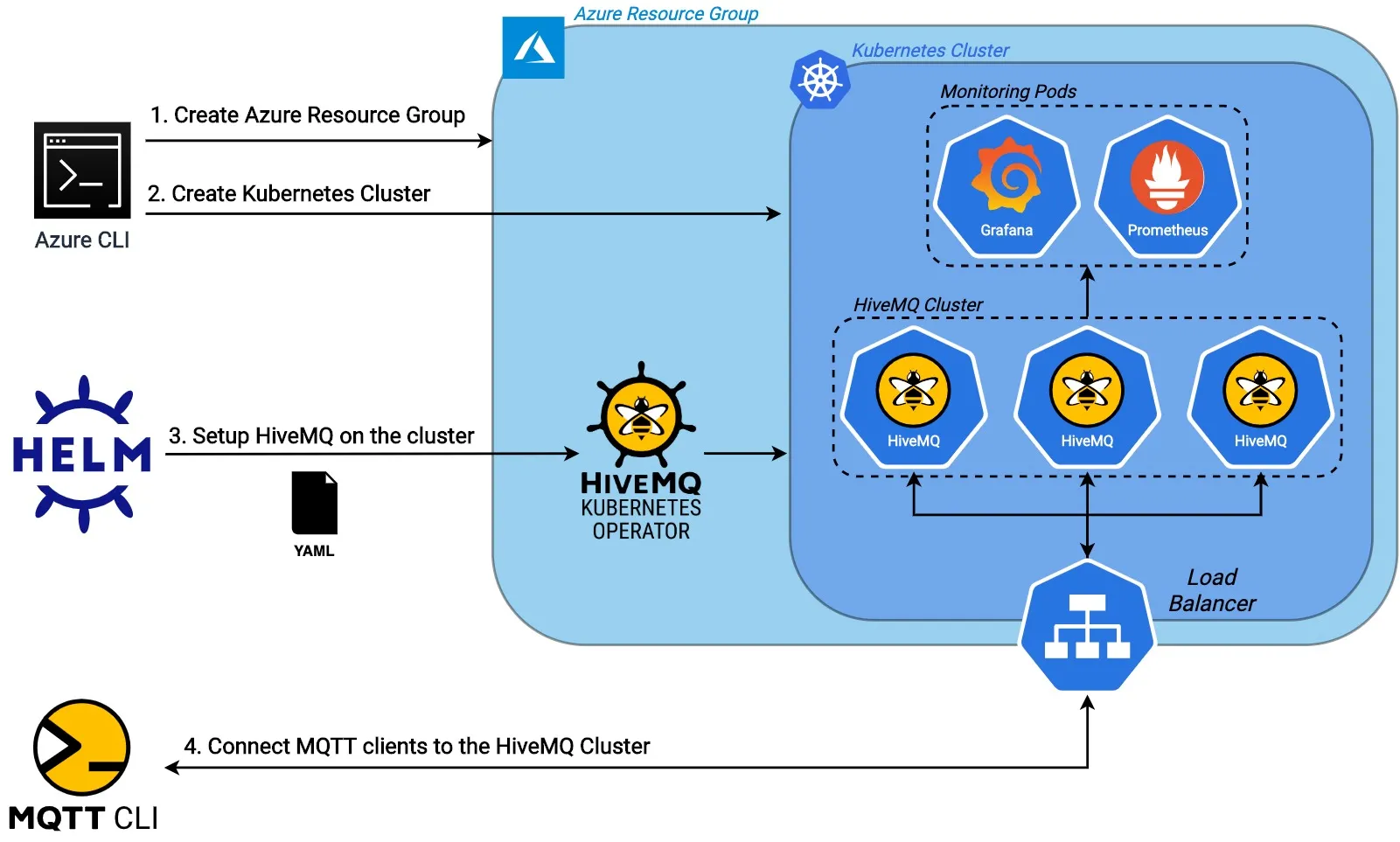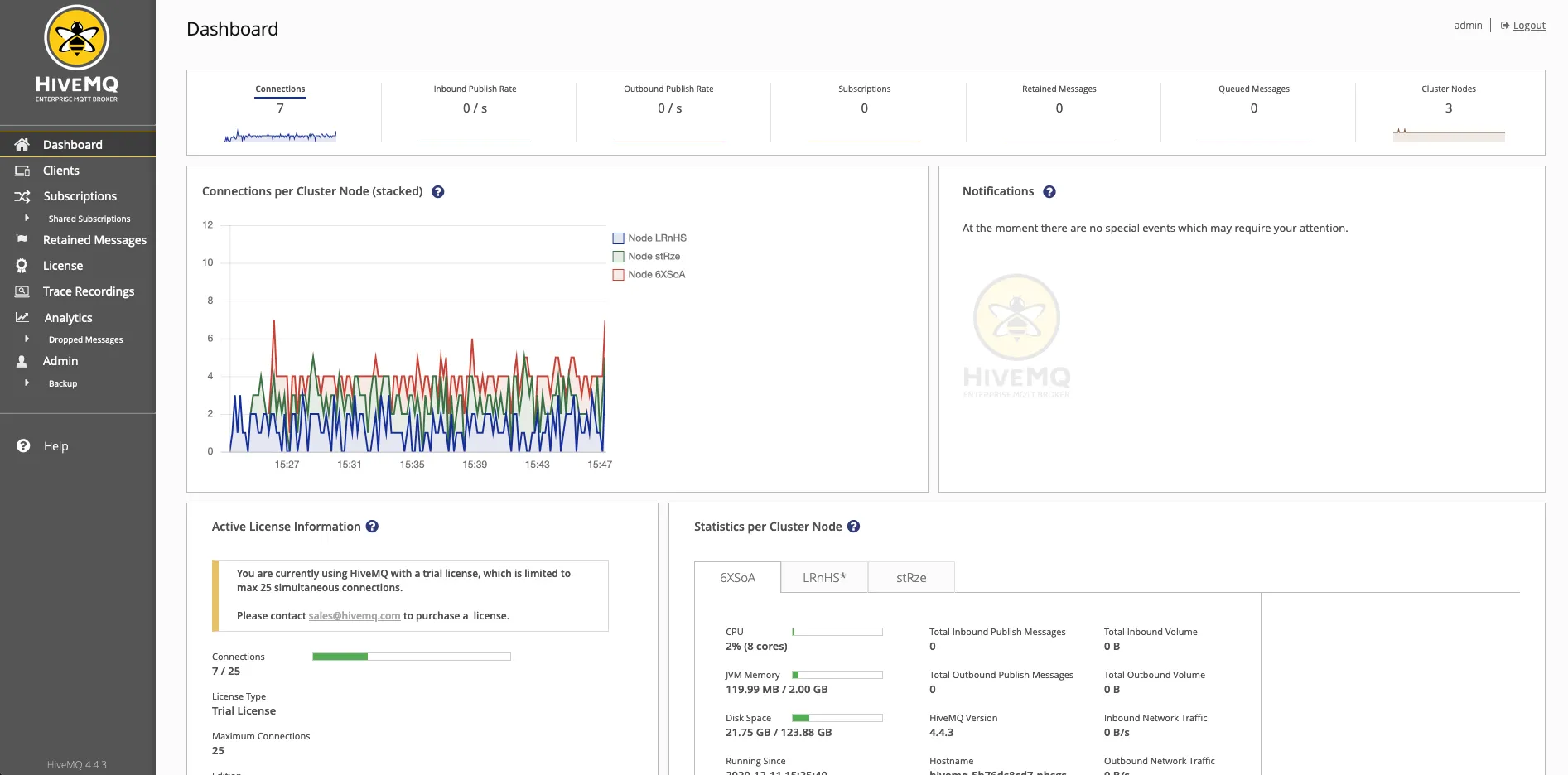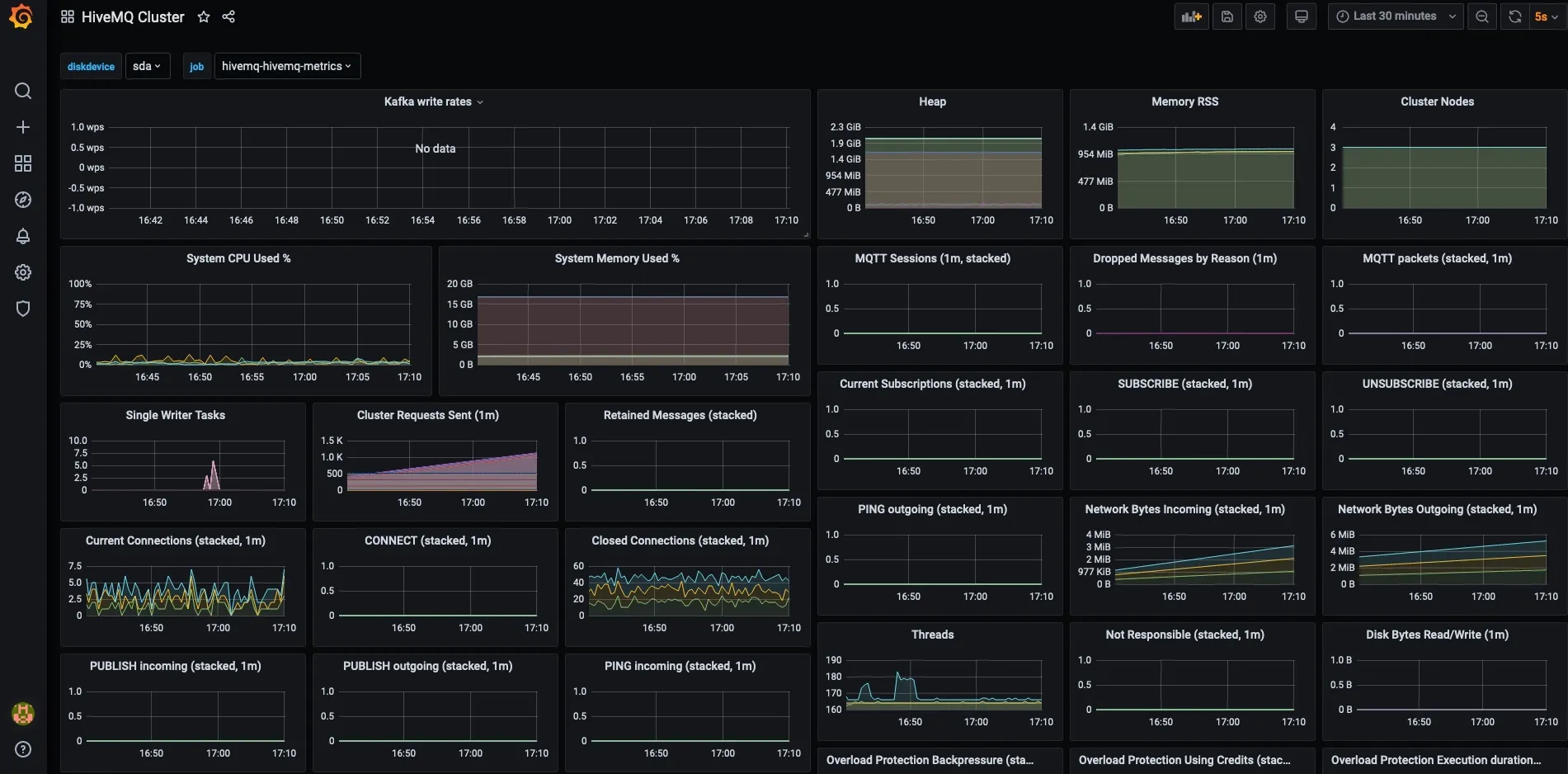HiveMQ with Azure Kubernetes Service (AKS)
Introduction
With the release of the HiveMQ Kubernetes Operator, deploying, configuring and running a high-available HiveMQ Cluster to the cloud has become easy and convenient. User only need to manage a single or very few YAML file(s) and the Operator will take care of orchestrating the entire cluster.
The HiveMQ Operator is built to work with any K8s cluster, as long as it is version 1.13 or later. This includes OnPrem installation as well as managed cloud offerings. Today’s blog post focuses on the use of Microsoft’s managed Azure Kubernetes Service (AKS). This service allows us to deploy a HiveMQ Cluster to the Azure Cloud in just a few steps:
 As illustrated in the image above we will use the Azure CLI to create an Azure Resource Group in which we will then deploy a 4-node Kubernetes Cluster. Next, we will use Helm to install the HiveMQ K8s Operator and use it with a customized YAML file to install a 3-node HiveMQ Cluster and to setup Prometheus and Grafana on the fourth node so that we can monitor HiveMQ. The HiveMQ K8s Operator will also define a Load Balancer that can be used to connect MQTT clients to the HiveMQ Cluster. For demonstration purposes we will be using MQTT-CLI.
As illustrated in the image above we will use the Azure CLI to create an Azure Resource Group in which we will then deploy a 4-node Kubernetes Cluster. Next, we will use Helm to install the HiveMQ K8s Operator and use it with a customized YAML file to install a 3-node HiveMQ Cluster and to setup Prometheus and Grafana on the fourth node so that we can monitor HiveMQ. The HiveMQ K8s Operator will also define a Load Balancer that can be used to connect MQTT clients to the HiveMQ Cluster. For demonstration purposes we will be using MQTT-CLI.
Prerequisites
Azure Account
In order to use the Azure services you need an Azure Account.
(Optional) HiveMQ License
Unless you have a valid HiveMQ license, the deployed HiveMQ Cluster will only be a trial version to evaluate HiveMQ. The cluster will be restricted to 25 concurrent connections in this case.
Contact us in case you want to evaluate HiveMQ with a bigger load.
Azure CLI
The Azure command-line interface is used to create and manage Azure resources. We will use it to create an Azure Resource Group and a Kubernetes cluster in it on the Azure cloud. You can install it on macOS via Homebrew:
brew install azFor other operating systems see the official Azure CLI installation documentation.
kubectl
kubectl is the official command-line interface to interact with Kubernetes clusters. We will use it to manage the created Kubernetes cluster on Azure. You can install kubectl on all operating systems by using the previously installed Azure CLI:
az aks install-cliHelm
Helm is the package manager for Kubernetes. It is used to easily define, install and update the software running on a Kubernetes cluster. We will use it to install and configure HiveMQ on the cluster. You can install Helm on macOS via Homebrew:
brew install helmFor other operating systems see the official Helm installation documentation.
MQTT-CLI
MQTT-CLI is a command-line interface provided by HiveMQ to quickly simulate MQTT-Clients. We will use it to connect clients and interact with our HiveMQ Cluster. You yan install MQTT-CLI on macOS via Homebrew:
brew install hivemq/mqtt-cli/mqtt-cliFor other operating systems see the official MQTT-CLI installation documentation.
Setup Kubernetes Cluster With AKS
The first step to deploy a HiveMQ Cluster on AKS is to create a Kubernetes cluster on Azure by using the Azure CLI. Open a terminal and use the command:
az loginThis will open your browser with a login page asking for your Microsoft credentials. After successfully submitting your credentials you should see a confirmation in your terminal.
Before you can create the cluster you need to choose a region for hosting. You can get a JSON of all available locations by using the following command:
az account list-locationsAfter having chosen your location (We will use ‘germanywestcentral’ in this guide), you need to create an Azure resource group, which holds all the necessary resources for your cluster:
az group create --name hmqResourceGroup --location germanywestcentralFinally, create a AKS-managed Kubernetes cluster consisting of four nodes with the Azure virtual machine type Standard_A8_v2 (8 CPUs, 16 GiB RAM) within this resource group (This may take some time):
az aks create -g hmqResourceGroup -n HiveMQCluster --node-count 4 --node-vm-size Standard_A8_v2In order to use kubectl to manage your previously created Kubernetes cluster you need to download the cluster’s access credentials:
az aks get-credentials -g hmqResourceGroup -n HiveMQClusterNext, you should be able to verify that your four nodes are available:
kubectl get nodesThe command should give you an output similar to this:
NAME STATUS ROLES AGE VERSION
aks-nodepool1-37471664-vmss000000 Ready agent 5m44s v1.18.10
aks-nodepool1-37471664-vmss000001 Ready agent 5m50s v1.18.10
aks-nodepool1-37471664-vmss000002 Ready agent 5m47s v1.18.10
aks-nodepool1-37471664-vmss000003 Ready agent 5m47s v1.18.10
(Optional) Add A License To Your HiveMQ Cluster
If you have a valid HiveMQ license make it accessible for the HiveMQ deployment in the next step by creating a Kubernetes ConfigMap hivemq-license from your license file:
kubectl create configmap hivemq-license --from-file=hivemq-license.lic
Deploy HiveMQ On The Cluster
Finally, we can use the HiveMQ K8s Operator to deploy and manage our HiveMQ Cluster on the Kubernetes nodes. For this we need to add the HiveMQ Helm repository to our Helm installation:
helm repo add hivemq https://hivemq.github.io/helm-chartsNext, you need to define the custom configuration YAML file for your HiveMQ Cluster. To create a 3-node HiveMQ Cluster with a load balancer exposing the MQTT port, access to the HiveMQ Control Center and a dedicated monitoring instance you can save the following configuration as a yaml file called hivemq.yaml:
hivemq:
nodeCount: "3"
ports:
- name: "mqtt"
port: 1883
expose: true
patch:
- '[{"op":"add","path":"/spec/type","value":"LoadBalancer"}]'
- name: "cc"
port: 8080
expose: true
patch:
- '[{"op":"add","path":"/spec/sessionAffinity","value":"ClientIP"}]'
# Uncomment the following lines if you have a valid HiveMQ license
# configMaps:
# - name: hivemq-license
# path: /opt/hivemq/license
monitoring:
dedicated: true
enabled: trueLastly, install the HiveMQ K8s Operator which will deploy the configured HiveMQ Cluster from the previously defined YAML file:
helm upgrade --install -f hivemq.yaml hivemq hivemq/hivemq-operatorYou can check if your cluster is running by using the following command:
kubectl get hivemq-clustersAs soon as the STATUS of the cluster has changed to Running you can proceed with the next steps.
Connect To Your HiveMQ Cluster
After the setup of your HiveMQ Cluster was successful you can now connect to it by using MQTT-CLI. Once more we need to use kubectl get hivemq-clusters to obtain the exposed ENDPOINT of the created load balancer on which we can then connect to our cluster:
$ kubectl get hivemq-clusters
NAME SIZE IMAGE VERSION STATUS ENDPOINT MESSAGE
hivemq 3 hivemq/hivemq4 k8s-4.4.3 Running 20.52.209.35 Live updates completed successfullyNext, we start up the shell mode of the CLI with the following command:
mqtt shIn the shell-mode we can connect a new MQTT client to our cluster on the previously acquired endpoint address:
con -h 20.52.209.35We now have successfully connected a new MQTT client to a HiveMQ Cluster hosted on Azure. Check out the MQTT-CLI documentation on how to further interact with HiveMQ.
Monitor HiveMQ
Control Center
The fastest way to get some insight into HiveMQ is by using the HiveMQ Control Center. We can get access to the Control Center by forwarding its port to our local machine:
kubectl port-forward svc/hivemq-hivemq-cc 8080:8080This will block the console and make the Control Center available on http://localhost:8080, where you can login by using the username admin and the password hivemq:
 Grafana
Grafana
To gain an in-depth view into HiveMQ you can use the Grafana dashboard provided by the HiveMQ Kubernetes Operator. To access the dashboard, forward its port to your local machine:
kubectl port-forward svc/hivemq-grafana 8081:80You can now access the Grafana dashboard by visiting http://localhost:8081 and logging into it by using admin as username and prom-operator as password. Then select the dashboard HiveMQ Cluster to access a pre-defined dashboard to get insights into the most important metrics of HiveMQ:
 Configure Your HiveMQ Cluster
Configure Your HiveMQ Cluster
You can easily adapt the HiveMQ Cluster to your needs by making changes to the YAML file and applying those changes via Helm. To get an overview of all the possible configuration options, which you may want to override use the following Helm command:
helm show values hivemq/hivemq-operatorAfter you have modified your YAML file according to your desired configuration you just need to apply it via Helm:
helm upgrade --install -f hivemq.yaml hivemq hivemq/hivemq-operatorThis will initiate a rolling upgrade of your cluster and updates it to the new desired state. You can track the state of your cluster by using kubectl get hivemq-clusters.
Tearing Down The Cluster
To delete the whole created cluster simply delete the Azure resource group by using the Azure CLI:
az aks delete -g hmqResourceGroup -n HiveMQClusterConclusion
This guide demonstrated how convenient it is to leverage the HiveMQ K8s Operator and a managed Kubernetes service in the cloud to quickly create a high availability HiveMQ Cluster with monitoring.
The same tools and principles can be used with other Kubernetes deployments. Let us know in the comments, if you have used the HiveMQ K8s Operator yourself.

Till Seeberger
Till is a software engineer at HiveMQ, driving innovation forward in the Internet of Things. He is a tenured member of the engineering team at HiveMQ and maintains the MQTT CLI open-source project. He spends his free time playing guitar and volleyball.
